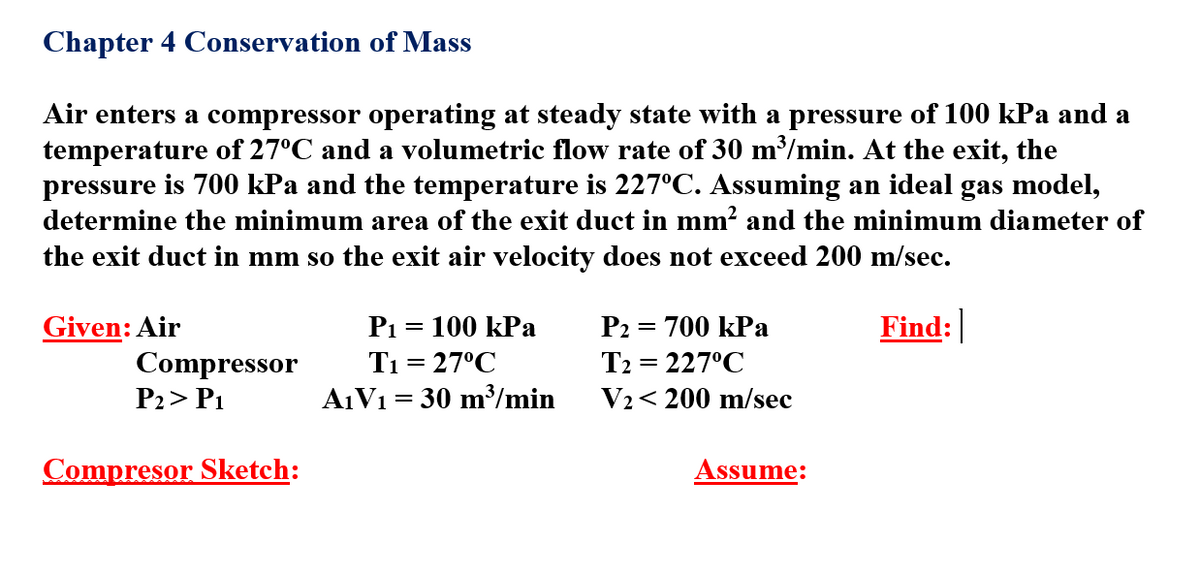Air enters a compressor operating at steady state with a pressure of 100 kPa and a temperature of 27°C and a volumetric flow rate of 30 m³/min. At the exit, the pressure is 700 kPa and the temperature is 227°C. Assuming an ideal gas model, determine the minimum area of the exit duct in mm? and the minimum diameter of the exit duct in mm so the exit air velocity does not exceed 200 m/sec. Given: Air P1 = 100 kPa P2 = 700 kPa Find: T1 = 27°C A1V1 = 30 m³/min Compressor T2 = 227°C %3D %3D P2> P1 V2< 200 m/sec Compresor Sketch: Assume:
Air enters a compressor operating at steady state with a pressure of 100 kPa and a temperature of 27°C and a volumetric flow rate of 30 m³/min. At the exit, the pressure is 700 kPa and the temperature is 227°C. Assuming an ideal gas model, determine the minimum area of the exit duct in mm? and the minimum diameter of the exit duct in mm so the exit air velocity does not exceed 200 m/sec. Given: Air P1 = 100 kPa P2 = 700 kPa Find: T1 = 27°C A1V1 = 30 m³/min Compressor T2 = 227°C %3D %3D P2> P1 V2< 200 m/sec Compresor Sketch: Assume:
Elements Of Electromagnetics
7th Edition
ISBN:9780190698614
Author:Sadiku, Matthew N. O.
Publisher:Sadiku, Matthew N. O.
ChapterMA: Math Assessment
Section: Chapter Questions
Problem 1.1MA
Related questions
Question
State what to find , assumption, and a simple sketch of the turbine. and then solve for the work output.

Transcribed Image Text:Chapter 4 Conservation of Mass
Air enters a compressor operating at steady state with a pressure of 100 kPa and a
temperature of 27°C and a volumetric flow rate of 30 m/min. At the exit, the
pressure is 700 kPa and the temperature is 227°C. Assuming an ideal gas model,
determine the minimum area of the exit duct in mm? and the minimum diameter of
the exit duct in mm so the exit air velocity does not exceed 200 m/sec.
Given: Air
P1
100 kPa
P2 = 700 kPa
Find:
Compressor
T1 = 27°C
T2 = 227°C
P2> P1
A1V1 = 30 m³/min
V2< 200 m/sec
Compresor Sketch:
Assume:
Expert Solution
This question has been solved!
Explore an expertly crafted, step-by-step solution for a thorough understanding of key concepts.
This is a popular solution!
Trending now
This is a popular solution!
Step by step
Solved in 3 steps with 1 images

Knowledge Booster
Learn more about
Need a deep-dive on the concept behind this application? Look no further. Learn more about this topic, mechanical-engineering and related others by exploring similar questions and additional content below.Recommended textbooks for you

Elements Of Electromagnetics
Mechanical Engineering
ISBN:
9780190698614
Author:
Sadiku, Matthew N. O.
Publisher:
Oxford University Press

Mechanics of Materials (10th Edition)
Mechanical Engineering
ISBN:
9780134319650
Author:
Russell C. Hibbeler
Publisher:
PEARSON

Thermodynamics: An Engineering Approach
Mechanical Engineering
ISBN:
9781259822674
Author:
Yunus A. Cengel Dr., Michael A. Boles
Publisher:
McGraw-Hill Education

Elements Of Electromagnetics
Mechanical Engineering
ISBN:
9780190698614
Author:
Sadiku, Matthew N. O.
Publisher:
Oxford University Press

Mechanics of Materials (10th Edition)
Mechanical Engineering
ISBN:
9780134319650
Author:
Russell C. Hibbeler
Publisher:
PEARSON

Thermodynamics: An Engineering Approach
Mechanical Engineering
ISBN:
9781259822674
Author:
Yunus A. Cengel Dr., Michael A. Boles
Publisher:
McGraw-Hill Education

Control Systems Engineering
Mechanical Engineering
ISBN:
9781118170519
Author:
Norman S. Nise
Publisher:
WILEY

Mechanics of Materials (MindTap Course List)
Mechanical Engineering
ISBN:
9781337093347
Author:
Barry J. Goodno, James M. Gere
Publisher:
Cengage Learning

Engineering Mechanics: Statics
Mechanical Engineering
ISBN:
9781118807330
Author:
James L. Meriam, L. G. Kraige, J. N. Bolton
Publisher:
WILEY